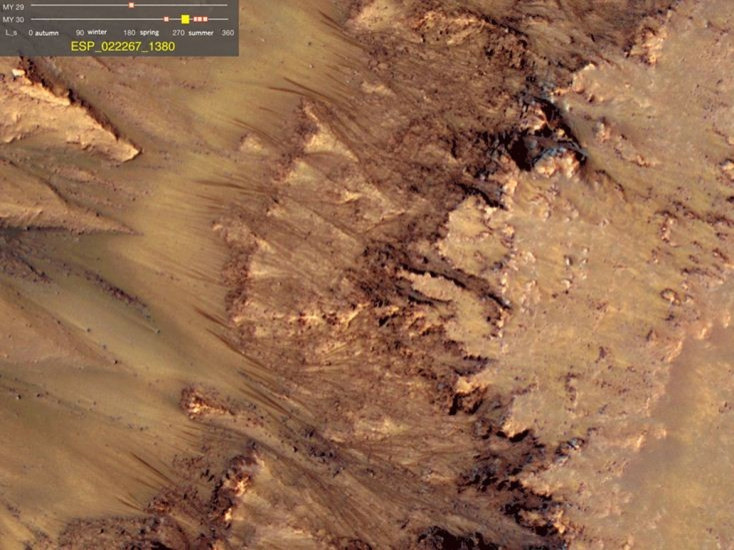NASA: Water on Mars Could Mean Life on Mars

[MUST READ] Solar Storm Watch: Could this be Armageddon?
Dark lines discovered on Mars by a search algorithm shows indications of flowing water on the surface. The discovery announced by NASA officials could be a huge breakthrough in the search for whether or not liquid water ever existed on the surface of Mars.
The algorithm, designed by University of Arizona student Lujendra Ojha, was designed to single out subtle changes on the surface over time by sorting through photos taken by the Mars Reconnaissance Orbiter that has been in orbit around Mars since 2006.
The mysterious dark lines in question were observed to be occurring seasonally as the ground they came from was exposed to warmer temperatures. The line would then disappear later as temperatures dropped, causing the scientists to speculate that briny water was causing the flows.
During the press conference, NASA officials speculated that it probably wouldn't take much water to cause the flows, if indeed it is water. "We're talking about for a typical flow something like a 100 liters, so 25 gallons is a pretty modest amount. But if there is a 1000 of them, then that starts to amount to multiple swimming pools worth of water."
The mysterious lines, called "recurring slope lineae," are estimated to be between 1.6 to 16 feet wide. The size of the lineae is rather small when compared to the larger gullies on Mars. The scientists were clear to point out that the larger gullies would have required a larger quantity of water to form than what was recently discovered.
The best explanation that researchers could give for the existence of liquid water was that they were seeing salty water, which has a lower freezing temperature. It is also possible that the liquid water exists due in part to a similar occurrence that has been observed in permafrost on earth.
NASA officials stated "If there was a fracture network that created a conduit that extended through the permafrost, on earth we would call that a talik which means that there are fluids that because of their saltiness create a column of unfrozen ground through the permafrost"
In the press conference, NASA officials also raised the possibility of how life such as micro-organisms could possibly survive in such an environment.
"If there were to have been life on Mars and if it evolved and adapted to this permafrost world, I think those are reasonable things that we could go look for." They went on to say, "If there are cold salty waters that never freeze, despite the cold frozen surrounding ground, then they simply remain active at all times, although at lower metabolic rates when the coldest temperatures occur. If the environment is one which it is liquid seasonally but pretty much freezes up solid at other times of the year, then that would have to be an organism that can go into a dormant state."
Although scientists are still speculating over the mysterious lines being caused by water, it still remains the best explanation.
According to Alfred McEwen, a co-author on the study that revealed the recurring slope lineae, "we've been trying to come up with alternate ideas, maybe some sort of dry avalanching process, but none of them work,". He added "Why does this only seem to happen at certain temperatures and latitudes, and why darken and fade? Briny water seems to be the most viable explanation for these observations so far."
McEwen and his team are hoping the NASA and the European Space Agency mission, ExoMars, will help produce more evidence in support of their discovery. The ExoMars launch in 2016 will send a probe to mars to detect trace gases in the Martian atmosphere, including water.
[MUST READ] Spectacular Photos of Solar Flares Detected by NASA
© Copyright IBTimes 2025. All rights reserved.





















